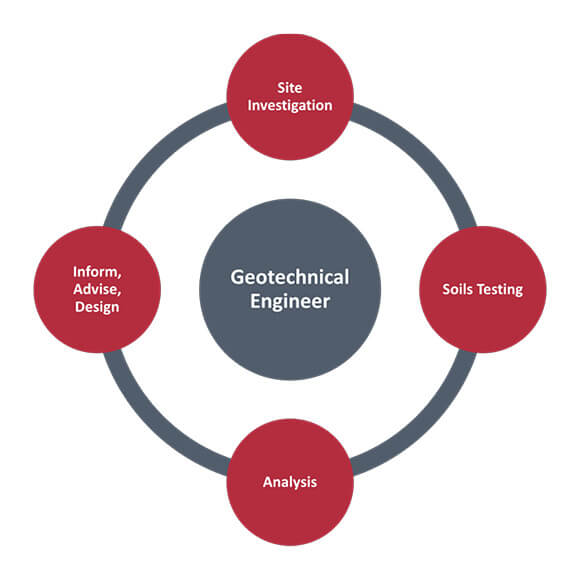Examine This Report about Geotheta
Examine This Report about Geotheta
Blog Article
5 Simple Techniques For Geotheta
Table of ContentsThe Geotheta PDFsGeotheta Can Be Fun For EveryoneSome Known Facts About Geotheta.Some Known Details About Geotheta Some Known Questions About Geotheta.

They conduct site examinations, gather samples, do laboratory tests, and evaluate information to examine the viability of the ground for building jobs - Geo Tech Engineering. Based upon their searchings for, geotechnical designers supply referrals for foundation design, incline stability, maintaining frameworks, and mitigation of geotechnical dangers. They team up with various other experts, such as engineers, structural engineers, and building groups, to ensure that geotechnical considerations are integrated right into the general task layout and application
By analyzing the actions and residential properties of soil and rock, they can identify possible geotechnical dangers such as landslides, soil negotiation, or slope instability. Their experience aids stop failings or accidents that might jeopardize lives and residential property. Here are some thorough tasks and duties of a geotechnical designer: Site Examination: Geotechnical designers conduct website investigations to collect data on subsurface problems.
They interpret the data to comprehend the properties and habits of the dirt and rock, including their toughness, permeability, compaction features, and groundwater conditions. Geotechnical Analysis and Style: Geotechnical engineers examine the information accumulated throughout website examinations to evaluate the security and suitability of the site for construction projects. They carry out geotechnical estimations and modeling to assess aspects such as birthing capability, negotiation, incline stability, lateral planet stress, and groundwater circulation.
Geotheta Can Be Fun For Anyone
Structure Design: Geotechnical engineers play an essential role in developing structures that can safely support the intended framework. They assess the soil problems and load needs to establish the suitable foundation kind, such as superficial foundations (e.g., footings), deep foundations (e.g (https://slides.com/geotheta)., stacks), or specialized techniques like soil renovation. They think about factors such as settlement limits, birthing ability, and soil-structure communication to establish optimal structure layouts
They examine construction plans, screen site activities, and conduct field assessments to confirm that the style referrals are adhered to. If unanticipated geotechnical concerns occur, they examine the circumstance and give referrals for removal or modifications to the design. Danger Analysis and Reduction: Geotechnical designers assess geotechnical hazards and threats related to the task website, such as landslides, liquefaction, or soil erosion.

Cooperation and Communication: Geotechnical engineers function closely with other specialists included in a project, such as designers, architectural designers, and building groups. Reliable interaction and partnership are vital to integrate geotechnical considerations into the total project style and building process. Geotechnical designers provide technological knowledge, response questions, and make certain that geotechnical demands are fulfilled.
Not known Incorrect Statements About Geotheta
Below are some kinds of geotechnical engineers: Structure Designer: Foundation designers concentrate on creating and examining foundations for structures. They analyze the dirt problems, lots demands, and website attributes to establish one of the most ideal foundation type and layout, such as shallow foundations, deep structures, or specialized methods like heap foundations.
They review the elements affecting incline security, such as dirt residential or commercial properties, groundwater problems, and incline geometry, and develop techniques to stop slope failures and reduce threats. Earthquake Engineer: Earthquake engineers specialize in examining and making structures to hold up against seismic pressures. They analyze the seismic Consulting Engineer threat of a website, review dirt liquefaction potential, and develop seismic design criteria to ensure the safety and security and strength of structures during earthquakes.
They carry out field screening, collect samples, and analyze the accumulated data to identify the dirt homes, geologic formations, and groundwater conditions at a site. Geotechnical Instrumentation Designer: Geotechnical instrumentation engineers concentrate on surveillance and determining the habits of dirt, rock, and frameworks. They set up and maintain instrumentation systems that check variables such as dirt negotiation, groundwater degrees, slope movements, and structural displacements to evaluate performance and offer early warnings of prospective problems.
Geotheta Can Be Fun For Everyone
They conduct tests such as triaxial examinations, consolidation examinations, straight shear examinations, and leaks in the structure tests to collect information for geotechnical analysis and layout. Geosynthetics Designer: Geosynthetics designers specialize in the layout and application of geosynthetic materials, such as geotextiles, geogrids, and geomembranes. They use these products to enhance soil stability, reinforce slopes, provide water drainage remedies, and control disintegration.
They have a tendency to be investigatory people, which indicates they're intellectual, reflective, and investigative. They are interested, methodical, sensible, logical, and rational. Some of them are additionally social, implying they're kind, generous, cooperative, client, caring, practical, empathetic, sensible, and friendly - Engineer of Record.
In the workplace environment, geotechnical engineers use specialized software application tools to carry out calculations, produce designs, and analyze information. They prepare records, testimonial task requirements, interact with clients and team members, and coordinate project activities. The office setup supplies a helpful environment for research, analysis, and cooperation with various other professionals involved in the project.
Some Known Details About Geotheta
They regularly visit task sites to perform site examinations, evaluate geotechnical problems, and collect information for evaluation. These gos to involve traveling to different areas, sometimes in remote or tough terrains. Geotechnical engineers may perform soil tasting, conduct tests, and display building and construction activities to make certain that the geotechnical facets of the project are being carried out appropriately.
Geotechnical engineers also work in specialized geotechnical labs. In these centers, they conduct experiments, perform examinations on dirt and rock examples, and assess the engineering buildings of the materials. Geotechnical research laboratory engineers function extensively in these atmospheres, handling testing equipment, running tools, and videotaping information. They team up with various other lab team to make certain precise and trusted testing results.
Report this page